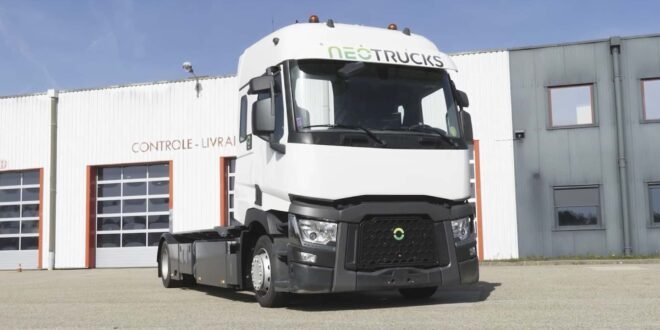The Rise of Electric Retrofits for Diesel Trucks
The transition to electric vehicles (EVs) is not limited to passenger cars. In fact, the commercial trucking industry is also undergoing a significant transformation. One notable example is the work being done by Neo Trucks, a French startup that specializes in converting old diesel-powered long-haul trucks into electric vehicles (EVs). This innovative approach offers a cost-effective alternative to purchasing brand-new electric trucks while addressing the need for cleaner and more sustainable transportation solutions.
A Collaborative Approach to Retrofitting
Neo Trucks has partnered with Renault Trucks to acquire used T-series tractors when their lease contracts end. These trucks are stripped of their engines and transmissions, leaving only the chassis and frame for retrofitting. Instead of relying on traditional powertrains, the startup installs an electric motor and a battery pack in place of the original components. This process not only reduces costs but also extends the life of existing vehicles, making it a practical solution for companies looking to reduce their carbon footprint without investing in entirely new fleets.
Design and Performance of Retrofitted Trucks
The retrofitted trucks are equipped with a single 174-horsepower (130-kilowatt) electric motor that powers the rear wheels. A modular battery pack, based on a 12-kWh unit, can be expanded to offer between 60 kWh and 120 kWh of energy. This design allows for flexibility in power capacity, depending on the specific needs of the user. While the motor’s power output may seem modest, it compensates with high torque, which is essential for the tasks these trucks are designed to perform.
These modified vehicles are not intended for long-haul service. Instead, they are tailored for use on private roads and properties such as shipping yards and logistics centers. Their maximum speed is capped at 15 miles per hour (25 kilometers per hour), which is sufficient for yard work and other low-speed operations.
Enhancements for User Experience
Neo Trucks has made several modifications to improve the driver’s experience. For instance, some cab designs include an opening at the back of the vehicle, allowing drivers to enter and exit without constantly opening and closing the regular door. This feature enhances convenience and efficiency during daily operations.
Additionally, the retrofitted trucks do not require registration or license plates, and drivers do not need a special heavy goods license since the vehicles are not used on public roads. Another notable feature is the ability of the fifth wheel to raise by up to 31 inches (80 centimeters), enabling drivers to pick up trailers without having to get out and manually adjust the landing gear.
Charging Capabilities
The retrofitted vehicles are equipped with a built-in onboard charger that allows them to draw up to 22 kW from the mains. They can also be charged using DC fast chargers at a rate of up to 80 kW. This flexibility in charging options makes the vehicles suitable for various operational environments.
A Niche Market with Big Potential
While the market for retrofitted electric trucks is still niche, the concept represents a promising step toward a more sustainable future. By repurposing existing diesel trucks, companies can reduce waste and lower the environmental impact of their operations. Moreover, this approach provides an accessible entry point for businesses that may not have the budget to invest in entirely new electric fleets.
As the demand for clean energy solutions continues to grow, initiatives like those led by Neo Trucks could play a crucial role in shaping the future of commercial transportation.
 Info Malang Raya Its All About World News
Info Malang Raya Its All About World News



